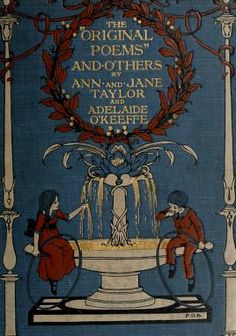Jane Taylor (poet) facts for kids
Quick facts for kids
Jane Taylor
|
|
|---|---|
| Born | 23 September 1783 London, England |
| Died | 13 April 1824 (aged 40) |
| Resting place | Ongar churchyard, Essex, England |
| Occupation | poet, novelist |
| Literary movement | Romanticism |
Jane Taylor (born September 23, 1783 – died April 13, 1824) was an English poet and writer. She is most famous for writing the words to the song "Twinkle, Twinkle, Little Star". Many people know the song, but they often forget who wrote it.
Jane and her sister, Ann Taylor, were both writers. Sometimes, people got their works mixed up because they published some of their early poems together. Ann Taylor's son, Josiah Gilbert, later explained the difference. He said that "My Mother" was written by Ann, and "Twinkle, Twinkle, Little Star" was written by Jane.
Contents
About Jane Taylor's Life
Growing Up and Family Life
Jane Taylor was born in London, England. Her family later moved to a place called Shilling Grange in Lavenham, Suffolk. You can still see her house there today. Her mother, Ann Taylor, was also a writer.
From 1796 to 1810, Jane lived in Colchester. Some people think she might have written "Twinkle, Twinkle, Little Star" while living there. However, other towns like Ongar and Lavenham also claim to be where the famous poem was written.
Jane came from a large family of writers. Her father, Isaac Taylor of Ongar, was an engraver and later became a minister. Her mother wrote several books offering advice, some of which were stories.
Jane Taylor's Writing Career
Jane Taylor and her sister Ann started writing poems for children. A publisher asked them to create a collection called Original Poems for Infant Minds. This book was published without the authors' names in 1804. Ann and Jane Taylor were the main writers, along with Adelaide O'Keeffe. Other family members also helped.
The book was very popular, so they published a second volume in 1805. Over time, the collection became well-known as the work of the Taylor family.
After the success of Original Poems, Ann and Jane Taylor published more poetry books. These included Rhymes for the Nursery in 1806 and Hymns for Infant Minds in 1810. In Rhymes for the Nursery, the poem "The Star" appeared. This poem is now famously known as "Twinkle, Twinkle, Little Star" and was set to a French tune.
Jane Taylor also wrote another well-known poem called The Violet. It starts like this:
Down in a green and shady bed,
A modest violet grew;
Its stalk was bent, it hung its head
As if to hide from view.
And yet it was a lovely flower,
Its colour bright and fair;
It might have graced a rosy bower,
Instead of hiding there.
Besides poems, Jane Taylor wrote novels. Her novel Display (published in 1814) was very popular and had many editions. She also wrote Essays in Rhyme in 1816, which included some important poems. Jane worked with her mother on a book called Correspondence between a Mother and Her Daughter at School (1817). She also wrote The Family Mansion. A Tale (1819) and Practical Hints to Young Females.
Jane Taylor became the editor of a religious magazine called Youth's Magazine. She wrote many short stories, essays, and poems for it. These were later collected in a book called The Contributions of Q. Q. Jane wrote many other pieces that were never published during her lifetime.
Her Final Years
Jane Taylor passed away on April 13, 1824, at the age of 40. She died from breast cancer. She was buried in the churchyard at Ongar in Essex. After she died, her brother Isaac gathered many of her writings. He also wrote a biography about her in a collection called The Writings of Jane Taylor, In Five Volumes (1832).
Jane Taylor's Lasting Impact
- Jane Taylor's most famous poem, "Twinkle, Twinkle, Little Star", is almost always sung without mentioning her name. It's so well-known that it feels like an old folk song, and many people don't know who created it.
- A famous funny version of "Twinkle, Twinkle, Little Star" appears in Lewis Carroll's book Alice's Adventures in Wonderland (1865). The Mad Hatter recites it.
- The poet Robert Browning mentioned Jane Taylor. He said that one of his later poems, "Rephan," was inspired by a story she wrote a long time ago.
See also
 In Spanish: Jane Taylor para niños
In Spanish: Jane Taylor para niños


